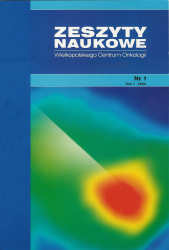Abstract
Prostate cancer is still a serious problem in the modern world. During the 36th ESTRO conference an attempt was made to determine which therapy is the best for patients suffering from this disease. Particular attention has been paid to the correct determination of the severity of the disease - according to the European Association of Urology (EAU) - which is the basis to treat patients in a proper way. The attention was also paid to the use of hypofractionaction and spacers used to healthy tissues protection.
References
Guidelines on Prostate Cancer. A. Heidenreich, M. Bolla, S. Joniau, M.D. Mason, V. Matveev, N. Mottet, H-P. Schmid, T.H. van der Kwast, T. Wiegel, F. Zattoni
What are the best ingredients to deliver the optima radiotherapy for prostate cancer. V. Khool, Royal Marsden Hospital Trust & Institute of Cancer Research, Department of Clinical Oncology, London, United Kingdom
Diagnostic accuracy of multi-parametric MRI and TRUS biopsy in prostate cancer (PROMIS): a paired validating confirmatory study. Ahmed HU, El-Shater Bosaily A, Brown LC, Gabe R, Kaplan R, Parmar MK, Collaco-Moraes Y, Ward K, Hindley RG, Freeman A, Kirkham AP, Oldroyd R, Parker C, Emberton M; PROMIS study group
Clinical evidence for hypofractionation In prostate cancer what is the optimum? P. Blanchard, Institut Gustave Roussy, Villejuif, France
FLAME: Investigate the Benefit of a Focal Lesion Ablative Microboost in Prostate Cancer (FLAME). M. van Vulpen, UMC Utrecht
High dose rate brachytherapy as monotherapy for localised prostate cancer: a hypofractionated two-implant approach in 351 consecutive patients. Nikolaos Zamboglou et al.
The role of spacers in the era of highly conformal, hypo-fractionated, image guided, adaptive radiotherapy of the prostate P. Scherer, F.Wolf,C.Gaisberger,F.Sedlmayer,Gemeinn. Sbg. Landeskliniken Betriebs. GmbH, University Clinic for Radiotherapy and RadioOncology, Salzburg, Austria
